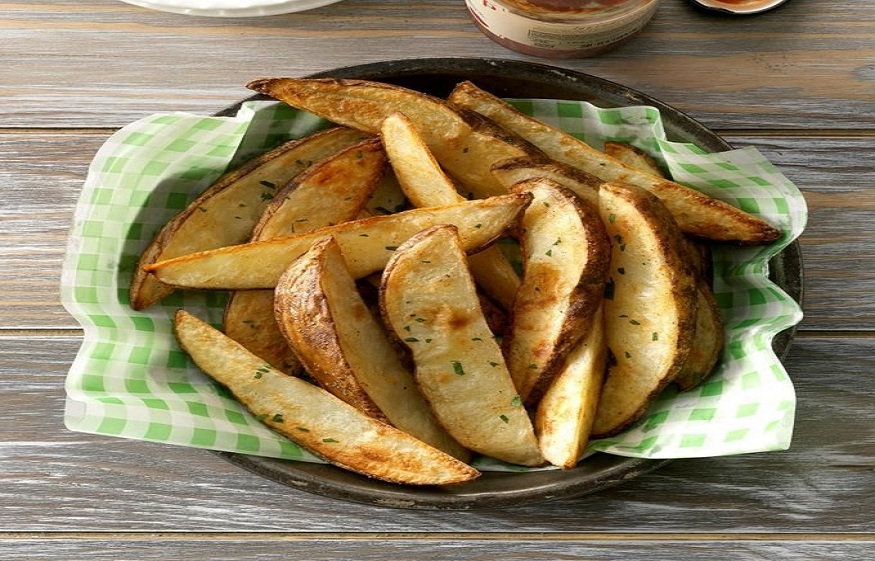Do purple spots in potatoes make eating them dangerous?

No, purple speckled potatoes are not poisonous. The rumor has been circulating on the Internet since the beginning of the year, often in the form of a Facebook publication, reproduced identically and already widely shared: the pinking of the flesh of the potatoes would be the sign of too much magnesium concentration, making them unfit for consumption, we read there. And that’s not all: a green spot would be a sign of too high a concentration of solanine, a deadly plant substance, and the potato should also be thrown away. Confusing and completely erroneous statements, explain the specialists.
WHAT THE RUMOR SAYS
False information almost invariably comes in the same form: a photo of potatoes from the ImageStock site, in the center of which has been embedded a photo of peeled potatoes, whose flesh is studded with purplish spots.
The text urges to “throw away” all the potatoes concerned, while warning about other color stains also presented as dangerous:
“If you find any potatoes that have a purple stain on the inside, don’t try to cut that stain and take the rest of the potatoes, but you have to throw them all away. This color indicates that there is a high concentration of magnesium and that means it is poisonous and it is dangerous to eat and if you find the stain is green then that means it has a concentration and it is rich in solanine and this ingredient is included in the composition of rat poison!
Therefore, you must be very careful if you find one of the two colors inside the potato, and throw it away. »
The publication has been widely shared since the beginning of 2020 on Facebook, particularly in French-speaking Africa, and taken up on certain health sites with little regard .
WHY THIS IS WRONG
Contacted by Le Monde , the National Interprofessional Potato Committee, the National Research Institute for Agriculture, Food and the Environment (Inrae) and the Arvalis Plant Institute are unanimous: they are delusional assertions.
“In almost forty years of activity on the potato, I have never seen purple spots linked to an excess of magnesium or publications mentioning this relationship” , is astonished thus Jean-Michel Gravoille, engineer at Arvalis and co-author of Ware Potato Culture :
In addition, magnesium is not toxic, on the contrary, it is a rather sought-after mineral in food. »
And to remember that it allows in particular to stabilize the heart rate, to regulate the level of sugar in the blood, to ensure nerve transmission or to relieve certain pains. A medium potato cooked and eaten with the skin provides about 50 mg of magnesium.
The presence of purple spots is not alarming, continues Jean-Michel Gravoille:
Roseval, a very well-known variety in France, can turn completely red, and black vitelotte has a naturally purple flesh. This type of pigment is also found in beets, red cabbage, certain varieties of carrots and even red wine. They have absolutely no toxicity
Solanine can be toxic to humans, but at very high doses
What about solanine, which rumors bring to an anxiety-provoking way of “rat poison” ? It is a natural substance present in many vegetables belonging to the nightshade family such as tomato or eggplant, and which can actually be toxic to humans, but only in very high doses. “It is normal to find it in a potato, [its] presence is taken into account and/or regulated for the registration of new varieties and a maximum recommended content is generally accepted for ware potatoes at 200 mg/kg, without risk of toxicity: we eat potatoes which contain much more in South America without this posing a problem” , reassures Jean-Michel Gravoille.
The quality monitoring carried out on the potatoes placed on the market also shows levels well below this threshold, he specifies. Moreover, the solanine level has nothing to do with the appearance of starchy foods. “The green color is not linked to the glycoalkaloid content [family of which solanine is a part] but to the presence of chlorophyll” , specifies Marie-Claire Kerlan, researcher at the Institute of Genetics Environment and Plant Protection of the ‘Inrae.
Chlorophyll is also the only agent that can make a good old potato unfit for consumption. “Potatoes can become toxic when they are very green after exposure to light and when eaten in large quantities, explains Jean-Michel Gravouille . But they are then bitter, it is not good. We don’t eat them, and the cases [of poisoning] that we know of were in times of famineIn summary, no, the purple spots are not toxic, magnesium is not bad for your health (quite the contrary), and as long as they are not completely green, the potatoes are perfectly harmless. Hoping that this article will have given you the fries.






